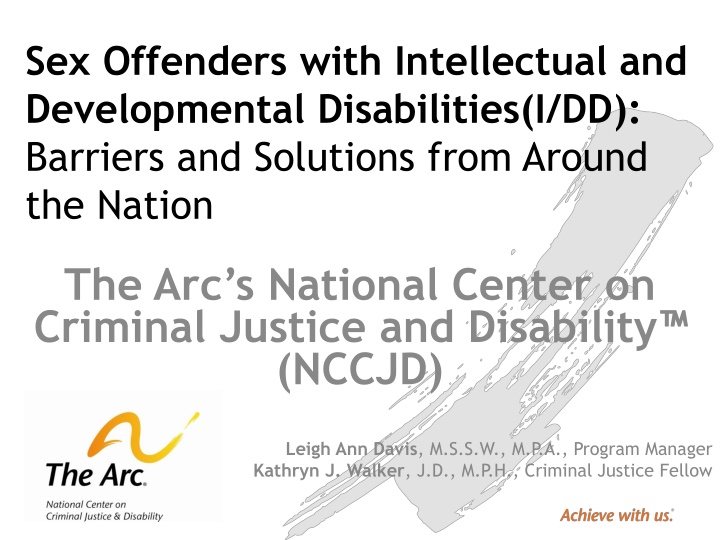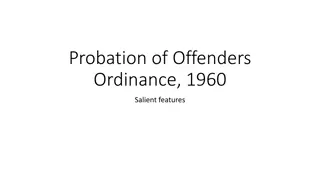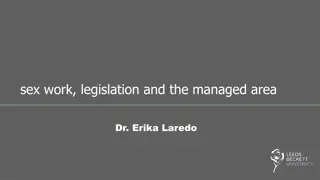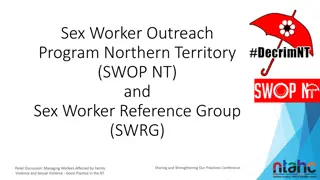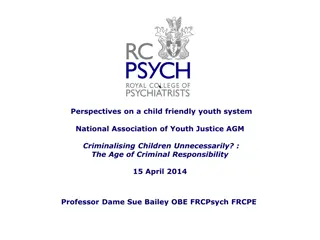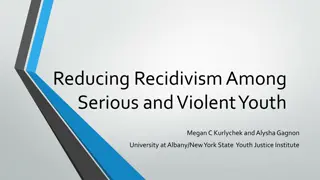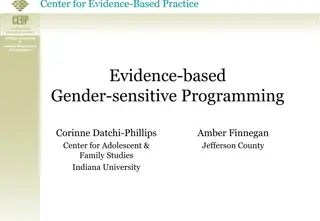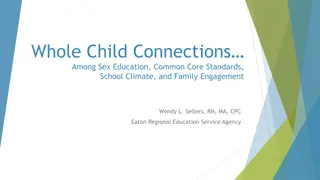Addressing Barriers Faced by Sex Offenders with I/DD
Explore barriers and solutions for sex offenders with Intellectual and Developmental Disabilities (I/DD) presented by experts in the field. Gain insights on disability basics, societal responsibilities, and stories from the system. Learn how professionals are working to tackle these complex issues.
Download Presentation

Please find below an Image/Link to download the presentation.
The content on the website is provided AS IS for your information and personal use only. It may not be sold, licensed, or shared on other websites without obtaining consent from the author.If you encounter any issues during the download, it is possible that the publisher has removed the file from their server.
You are allowed to download the files provided on this website for personal or commercial use, subject to the condition that they are used lawfully. All files are the property of their respective owners.
The content on the website is provided AS IS for your information and personal use only. It may not be sold, licensed, or shared on other websites without obtaining consent from the author.
E N D
Presentation Transcript
Sex Offenders with Intellectual and Developmental Disabilities(I/DD): Barriers and Solutions from Around the Nation The Arc s National Center on Criminal Justice and Disability (NCCJD) Leigh Ann Davis, M.S.S.W., M.P.A., Program Manager Kathryn J. Walker, J.D., M.P.H., Criminal Justice Fellow
Welcome! First time using webex? You can communicate using the Chat Box and seek technical assistance if needed. You can type questions about the material presented in the Q&A section. Use this link for live captioning: http://streamtext.net/text.aspx?event=Arc Today s webinar will be recorded and archived on the NCCJD website. Please keep this in mind when sharing information and experiences during the webinar.
Leigh Ann Davis, M.S.S.W., M.P.A., Program Manager Kathryn Walker, J.D., M.P.H., Criminal Justice Fellow INTRODUCTION
Thank you to all our presenters Blake, Self-Advocate, and Brian, Family Advocate Carol, Family Advocate, and Adam Jessica Oppenheim, Esq., Director of The Arc of New Jersey s Criminal Justice Advocacy Program Randy Shively, Ph.D., Alvis House, Columbus, Ohio Dr. Elise Magnuson, Psy.D., LCSW Marc Goldman, MS, LPA Colleen Mercuri-Johnson, MSW, LISW-S, Butler County Board of Developmental Disabilities, Hamilton, Ohio Chris Snell, Director of the TREE program at CLASS Elizabeth Kelley, Attorney at Law, National Association of Criminal Defense Lawyers Board Member
Disability Basics: Understand: Know the challenges people with disabilities face Understand: Knowing one person with a disability means you know ONE PERSON with a disability Understand: This is a human rights issue just like race, gender, and religion
Points to Remember These are hard issues to discuss, and are rarely as clear-cut as we would like People with disabilities should take responsibility for their actions; likewise society should acknowledge true risk You don t have to reinvent the wheel around these issues there are seasoned professionals doing great work.
Blake STORIES FROM THE SYSTEM
How this has affected Blake Bullying, people check the internet and harass me. Treated as an outcast Fear of the police, fear of going back to jail for any minor issue Don t trust anybody, Fear of driving in that town where the incident occurred Limited where I can live Housing opportunities - discriminated/not allowed Unable to live in disability support housing. Post-traumatic stress disorder (PTSD) triggered by this terrifying event Depression, flashbacks, nightmares, Severe anxiety and uncontrollable thoughts about the event Sense of hopelessness This happens weekly. Can not purse my hopes of a career in psychology and very few other options A scared of meeting new people feeling like they already have a judgment Limited in where I can go. I can t even travel to see my grandmothers in Florida. I have to check in and out of each state every time I go back and forth to school.
How it has affected our family Caused depression. Mistrust of judicial process. How could our justice system be so inhuman. No second chance at life Even the medical experts involved with the case could not believe it went this far. How can this be fair and just, when drug dealers and terrorist do far worse and are not marked for life. Yet one incident he, our family and his future family are marked for life People have harassed my wife at work; stress in the family People have harassed my younger son. Because of this, he is limited in the services he is entitled to as part of his disabilities, particularly group homes, or housing. Unemployment is 10 -15% higher for people with disability, let alone being on the registry. practically impossible for him to have any type of life and career. His What happens to him after we are gone. If he is pulled over for even a broken taillight, he could be taken off to jail. He needs help in understanding all of the restrictions of being on the list with his disability. One mistake would put him in jail immediately, even a clerical error. We or some one from his autism program must go with him when he registers. It causes trauma, depression and withdrawal every time he has to register. The alleged victim continues to taunt him every year on the anniversary of the event. Financially it has cost all of our savings It has been total devastation to our entire family every day of our lives. There is always something that happens, whether it is something someone sees on the internet , or where we are going that day. It has been a living nightmare everyday of our lives and fear of what could happen to him.
Adam STORIES FROM THE SYSTEM
Jessica Oppenheim, Esq., Director of The Arc of New Jerseys Criminal Justice Advocacy Program SEX OFFENDER REGISTRATION AND COMMUNITY NOTIFICATION LAWS
Criminal Conviction/Juvenile Adjudication Diagnosis of a developmental disability is not a bar to criminal charges as a juvenile or adult In every State, a conviction for a sex offense now carries with it the obligation to register as an offender and be subject to some level of community notification
Obligations Created Registration for conviction, adjudication or not guilty by reason of insanity by filling out a Form on a regular basis Community Notificationof registrant s home address, place of employment, and place of schooling, in some cases with information included on an internet website
Registration Statutes The intent of the statute is to provide reliable information about the whereabouts of criminal offenders who have been convicted of an enumerated sex offense The goal of the statute is to allow the State the ability to supervise and oversee offenders even after they have been released into the community
Consequences Housing Options Access to Public Housing is limited by the requirement to register Offenders sentenced to some form of parole or community supervision for life may have conditions placed on them which bar them from living in households with minor children Some States have statutes which bar offenders from living within proximity of schools Supported housing providers can be uncomfortable serving this population
Consequences Job Opportunities Supported job options and rehabilitation services may limit registered sex offenders from accessing services Parole officers supervising offenders can impose conditions on work choices Background checks more than 90% of companies perform background checks
Consequences Increased Anxiety Individuals with I/DD must comply with conditions and obligations and may find it challenging to maintain compliance independently New Charges Failure to comply can result in new criminal charges and new prison sentences
Randy Shively, Ph.D., Alvis House, Columbus, Ohio RISK ASSESSMENT: EFFECTIVE MODEL FOR DD INDIVIDUALS WITH SEXUAL ISSUES
Proportionally More Sex Offenses Higher proportion of sex offenses with DD offender population when compared to the non-DD offender population Why? Why? Why?
Why more sex offenses? Fewer dating opportunities Belief in ID world that those with cognitive delays are asexual Less tolerance of sexual deviance in community Poor social skills-poor decision making
Million Dollar Question Is the DD client s sex offending due to true deviance or due to a lack of understanding of his sexuality and environment or both? Paraphilias may be grossly overestimated- keys are arousal and fantasy
Risk Assessment with the ID Risk can never be accurately predicted but it can be effectively managed External factors affect risk: need for staff supervision, quality of staff supervising, specific triggers for client in the environment, structure of schedule
Risk Assessment with ID Internal Factors affect risk: physical condition, stability from mental health medications, daily mood, diet, thinking errors and feeling about staff and current environment True mistakes can be made with this population when inappropriate sexual behavior is automatically assumed to be deviant
Promising Instruments Phenix and Sreenivasan (2009) list of DD specific risk factors: Social skills deficits; Committing violent offenses; being unemployed; psychiatric history; substance use disorder; easily susceptible to the influence of others; history of delinquency; poor response to treatment; antisocial attitude; low self-esteem; impulsivity to sexual acting out; high static risk
Promising Instruments Socio-sexual Knowledge and Attitudes Assessment Tool-Revised (Griffiths and Lunsky) Identifies with concrete pictures the understanding and preferences in the areas of : Anatomy, Men s and Women s Bodies, Intimacy, Pregnancy, Birth Control, Healthy Boundaries
Promising Instruments Assessment of Risk and Manageability of Individuals with Developmental and Intellectual Limitations who Sexually Offend (ARMIDILO-S) Boer et al, 2012 Stable items: supervision compliance, treatment compliance, sexual deviance, sexual preoccupations, emotional coping, relationships, impulsivity, substance abuse, mental health
ARMIDILLO-R: Acute Acute items: changes in client s compliance with supervision and treatment; changes in sexual preoccupation, changes in victim- related behaviors, changes in emotional coping, changes in the use of coping strategies, changes in monitoring, changes in social relationships, situational changes, changes in victim access
Model for ID Risk Assessment Assess Intellectual Delays related to risk Assess Mental Health problems related to risk Assess offending behaviors/history
Model for ID Risk Assessment- Intelligence Intelligence Level: do they understand right from wrong? Do they understand consent? Do they understand what consequences are connected to their behaviors? Can they pick out important cues in their environment linked to pro-social behaviors? Do they have an adequate immediate or short-term memory? Are they slow at processing new information? Do they have a developmental disability?
Intelligence: Key Question Does their cognitive delays help explain some of the bad decisions related to their offending behaviors? What concrete learning strategies might help manage risk of offending?
Model for ID Risk Assessment- Mental Health Mental Health Issues: what is the working diagnosis? Which diagnoses are not currently accurate? What is the client s current mental status? Is the client stable on their medications? Are they compliant in taking their medications? Can they self medicate? Do they need supervision taking their medications? Is the team working well with their psychiatrist? Do they understand their own diagnoses?
Key Questions: Mental Health How does the client s current mental health symptoms impact managing the client s risk? What can be done to stabilize client s negative symptoms? Were any delusions or hallucinations associated with offending behaviors?
Offender Risk History Has this client had official charges or behaviors which could have been prosecuted? Is this client motivated to stay out of trouble or do they have an antisocial attitude? What triggers the client s behaviors and are they successfully managing triggers?
Offender Risk History Are they fully aware of the consequences of their behaviors? How much disclosure do they have about the behaviors which have been documented? What types of thinking errors do they use when they discuss their offenses?
Offender Risk History Any history of violence? Violence used in offense(s) Family role models- history related to client How does current Behavior Support Plan address risk? What is in Individual Support Plan?
Staff Issues Be very aware of the possibility what you are told is only part or none of the truth= investigate Do not argue with SO they often use anger to try and control the situation Separate the sexual behavior from the person= only attack behaviors, not the person
Staff Issues Realize many of the SO clients do not know who they are- they struggle with an identity separate from their offense Communication with other staff is vital for the success of the program- the SO goal is to split staff
Effective Staff Attributes Be consistent Be professional Be firm and fair Be a resource
Staff have tremendous power in our interactions with our clients I ve come to the frightening conclusion that I am the decisive element in the consumer s life. It s my personal approach that creates the climate; it s my daily mood that makes the weather. I possess a tremendous power to make a consumer s life miserable or joyous. I can be a tool of torture or an instrument of inspiration; I can humiliate or humor, hurt or heal. In all situations, it is my response that decides whether a crisis will be escalated or deescalated and a consumer humanized or dehumanized Ginott, 1993
Contact Randy Shively, Ph.D.- Alvis House- 2100 Stella Ct., Columbus, 43215, 614-252-8402 randy.shively@alvishouse.org
References Ashford, J., Sales, B., and Reid, W. 2001. Treating adult and juvenile offenders with special needs. American Psychological Association: Washington, DC. Lindsay, W. 2009. The treatment of sex offenders with developmental disabilities: A practice workbook. Wiley-Blackwell: Malden, MA. Lindsay, W., Taylor, J., and Sturmey, P. 2004. Offenders with developmental disabilities. John Wiley and Sons, Ltd.: West Sussex, England. National Association for the Dually Diagnosed. 2007. Diagnostic manual- intellectual disability: A clinical guide for the diagnosis of mental disorders in persons with intellectual disability. Kingston, NY. Seligman, L. 1998. Selecting effective treatments: A comprehensive guide to treating mental disorders. Jossey-Bass, Inc.: San Francisco, CA. Quinsey, V., Harris, G., Rice, M., and Cormier, C. 1998. Violent offenders: Appraising and managing risk. American Psychological Association: Washington, DC. Center for Sex Offender Management. 2000. Myths and facts about sex offenders. (csom.org/pubs/mythsfacts) Harris, J., and Hanson, RK. 2004. Sex offender recidivism: A simple question. Public Safety and Emergency Preparedness: Canada.(www.psepc-sppcc.gc.ca) Finkelhor, D and Jones, L. 2004. Explanation for the decline in child sex abuse cases. Office of Juvenile and Delinquency Prevention. (ncjrs.gov/pdffiles1) Bureau of Justice Statistics. 2001. Data collection national crime victimization survey. (bjs.gov/index) Heil, P., Ahlmeyer, S., and Simons, D. 2003. Crossover sexual offenses. A Journal of Research and Treatment, vol 15(4). US Dept of Justice. Full report of the prevalence, incidence and consequences of violence against women. (ojp.usdoj.gov/nij). Dornin, C. 2010. Facts and fiction about sex offenders. University of Cincinnati. (corrections.com/news/article/24500-facts-and-fiction-about-sex-offenders).
Elise C. Magnuson, Psy.D., LCSW PSYCHOSEXUAL ASSESSMENTS
Psychosexuals What are they? An evaluation of a person who is charged with a sex offense or has committed one. Inform teams and legal decision makers Used to develop risk management plans
Psychosexuals what they are not Able to tell if someone committed a sex offense If someone will commit a sex offense NOBODY CAN TELL THE FUTURE
Psychosexuals Assessment of Risk Compare one person to a group of other people Actuarial Static-99 Structured Clinical Judgments Armadillo takes into account the support team around the person, designed specifically for people with an intellectual disability
Psychosexuals -- Risks Over or underestimating the impact of an intellectual disability Over or underestimating risk Blaming people rather than understanding what is Benefits Clear understanding of the person Help teams develop plans for supporting the person Provide information to decision makers
Risk Factors The factors that are risks for people to reoffend are the same, regardless if they have an intellectual disability Don t discount the risk because it s not their fault Don t discount the importance of the environment in managing risk.
Treatment Planning Make sure it s tailored to the person. Needs to take into account cognitive functioning. Make sure to use supports that are in place or get more supports as needed.
Tips for Teams Don t over or underestimate risk. Communication among team members is critical. Everyone needs to be informed about the risk and any plans for supporting the person. Consistency in the message to the person
